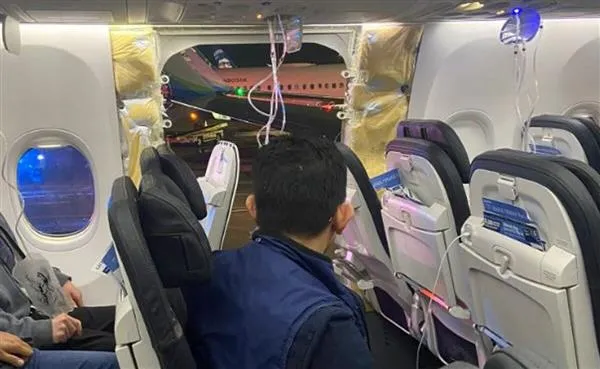Alaska Airlines, You’re talking about an incident that happened recently, on Friday, January 5, 2024, involving Alaska Airlines. New Boeing 737 Max 9 aircraft operated by Alaska Airlines was forced to make an emergency landing at Seattle-Tacoma International Airport due to a stunning explosion of its fuselage in midair. No one was hurt in the incident, despite the jet carrying 189 passengers and staff members.
cause of the blowout

The cause of the blowout is still under investigation, but some aviation experts have suggested that it could be related to a design flaw in the new aircraft model. The fuselage that blew off covered a space reserved for an extra evacuation door, which was not installed on the plane. This could have created a weak spot in the structure, making it vulnerable to stress and pressure.
Current status
The incident has prompted Boeing to ground all 197 of its 737 Max 9 planes worldwide, pending further inspection and review. This is another major setback for the company, which had already faced two fatal crashes involving its 737 Max 8 model in 2018 and 2019, killing 346 people. The 737 Max series was banned from flying for nearly two years until it was cleared to resume service in late 2020.
following are some current status:
- Investigation ongoing: The NTSB investigation is still ongoing, and the exact cause of the incident is yet to be determined.
- Grounding continues: As of today, January 7th, 2024, the grounding of Boeing 737 Max 9 aircraft remains in effect.
- Safety concerns: This incident has raised concerns about the safety of the Boeing 737 Max aircraft, particularly the Max 9 model.
questions that were raised after this incident
The incident has also raised questions about the safety and oversight of the aviation industry, especially in the wake of the COVID-19 pandemic, which has severely affected the demand and supply of air travel. Some critics have accused Boeing of rushing the production and certification of its new planes, compromising quality and reliability. Others have called for more transparency and accountability from the regulators and airlines, who are responsible for ensuring the safety of the passengers and crew.
National Transportation Safety Board (NTSB)

The National Transportation Safety Board (NTSB) is leading the investigation into the incident, along with the Federal Aviation Administration (FAA) and Boeing. The NTSB chair said that they were " very lucky" that the accident wasn’t far worse, and that it could have been " more tragic" if the blowout had occurred at a higher altitude or speed. The NTSB is expected to release a preliminary report on the incident within a month, and a final report within a year.
conclusion
The incident of Alaska Airlines was a shocking and rare event that exposed the potential risks of flying on a new aircraft model. The Boeing 737 Max 9 plane suffered a blowout of its fuselage in mid-air, but luckily, no one was harmed thanks to the quick actions of the pilots and crew. The incident has led to the grounding of all 197 planes of the same model worldwide, as well as an investigation by the authorities and the manufacturer. The incident has also raised concerns about the safety and oversight of the aviation industry, especially after the previous crashes involving the Boeing 737 Max 8 model. The incident of Alaska Airlines is a reminder of the importance of ensuring the quality and reliability of the planes that carry millions of passengers every day.



